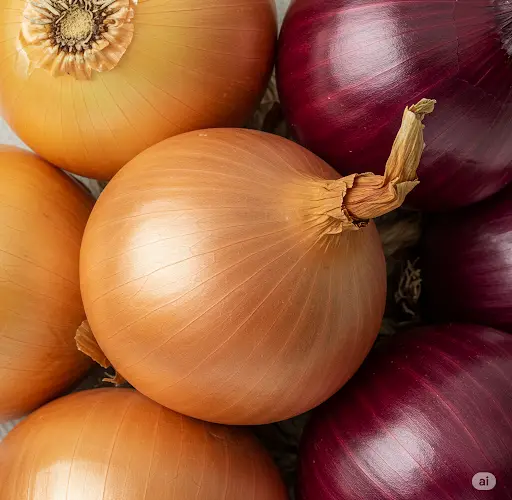Growing a bountiful onion crop doesn’t have to be complicated, but success starts with the way you sow your seeds or sets. Many gardeners struggle with small bulbs, poor sprouting, or plants that bolt prematurely. The secret to large, healthy onions lies in the right sowing method — and once you try this one, you may never go back.
This method ensures uniform growth, strong roots, and bigger bulbs at harvest time. Here’s how to do it right from the very beginning.
Why the Sowing Method Matters
Whether you grow onions from seed, sets, or seedlings, the way they’re sown has a major impact on their development. Poor spacing, compacted soil, or improper depth can lead to weak growth or underdeveloped bulbs. A well-thought-out sowing strategy gives your onions the best chance to grow large and store well.
This method has been tested over multiple seasons and consistently delivers an excellent harvest.
Start with Quality Onion Sets or Seeds
If you want a reliable onion crop with minimal effort, start with healthy, disease-free onion sets. These are small immature onions that are easy to plant and grow quickly.
Alternatively, if you’re growing from seed, choose a variety suited to your climate (long-day or short-day types). Onion seeds can take longer to germinate, but they offer more control and variety selection.
Either way, make sure your planting material is firm, fresh, and free from rot or mold.
Pre-Soak for a Better Start
Before sowing onion sets, soak them in warm water for 2–4 hours. This simple step softens the outer skin, encourages quicker rooting, and wakes the bulbs from dormancy. If you’re using seeds, soak them overnight for improved germination.
For an even stronger start, add a drop of aloe vera juice or a few grains of potassium humate to the soaking water. These natural boosters help stimulate root growth and resist early-season stress.
Prepare the Soil Like a Pro
Onions love loose, fertile, and well-drained soil. Before sowing, loosen the soil to a depth of at least 20 cm (8 inches). Mix in mature compost and a handful of wood ash or bone meal — onions thrive in potassium- and phosphorus-rich environments.
Avoid fresh manure, which can lead to overly lush green tops and small bulbs.
Soil pH should be around 6.0 to 7.0. If your soil is acidic, a light dusting of garden lime can help bring it into balance.
Spacing: The Key to Large Bulbs
The secret to large onions? Proper spacing. Each onion needs enough room to swell underground. Plant sets or seedlings about 10–12 cm (4–5 inches) apart in rows that are spaced 25–30 cm (10–12 inches) apart.
If sowing seeds, thin the seedlings after germination so each plant has its own space. Crowded onions may grow plenty of green tops, but the bulbs will stay small.
This sowing method prevents overcrowding, improves airflow, and reduces the risk of fungal disease
Don’t Bury Them Too Deep
When planting sets, press them gently into the soil so that the tip is just barely visible above the surface. Planting too deep can delay growth or lead to rotting.
For seeds, sow them shallowly — about 1 cm (less than half an inch) deep — and cover lightly with soil or fine compost.
Water gently after planting to settle the soil.
Mulch and Moisture
Once your onions are up and growing, mulching around the plants can help retain moisture, suppress weeds, and regulate soil temperature. Use straw, dry grass clippings, or finely shredded leaves.
Onions prefer evenly moist soil but dislike waterlogging. Water regularly during dry spells, especially as bulbs begin to swell in late spring or early summer.
Cut back on watering as harvest approaches — this helps bulbs dry and cure properly.
Feeding for Big Bulbs
Feed your onions every 2–3 weeks with a light application of compost tea, diluted fish emulsion, or a potassium-rich organic fertilizer. Avoid high-nitrogen feeds late in the season, as they encourage leaf growth instead of bulb development.
A good mid-season booster is a mix of:
-
1 tablespoon wood ash (potassium)
-
1 liter of water
-
Optional: a teaspoon of seaweed extract
Water this gently around the base of the plants for strong bulb formation.
Harvest and Cure Properly
You’ll know your onions are ready to harvest when the tops yellow and fall over. Gently loosen the soil and lift the bulbs. Allow them to dry in the sun for 3–5 days, then move them to a sheltered, well-ventilated area to finish curing for several weeks.
Once the necks are fully dry and the outer skins are papery, trim the tops and store your onions in a cool, dark place. Properly cured onions can last for months.
Final Thoughts
This sowing method — using pre-soaked sets, proper spacing, and well-prepared soil — has helped many gardeners achieve consistently large onion crops year after year. It’s simple, effective, and doesn’t require expensive inputs or chemicals.
Try it this season, and you may find yourself saying the same: “I sow onions only this way — and the harvest never disappoints.”
